Pioneer K016 User Manual
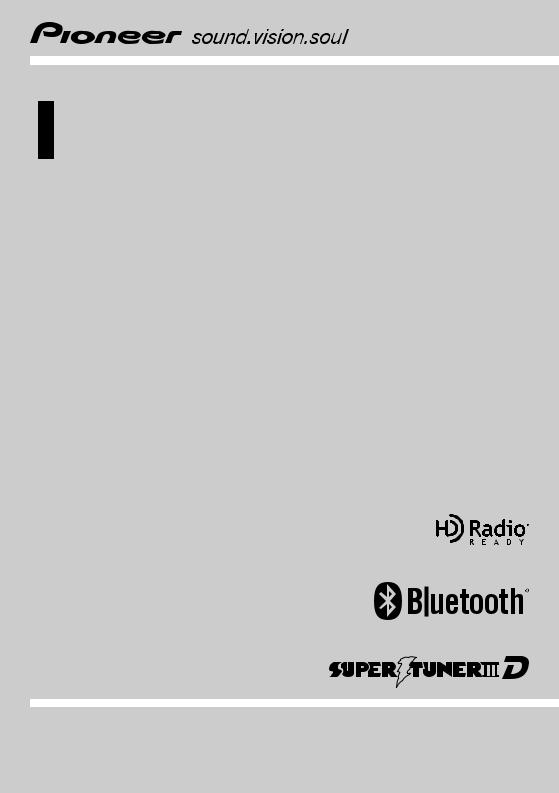
Operation Manual
CD RECEIVER
DEH-P7000BT
English


 Contents
Contents
Thank you for buying this Pioneer product.
Please read through these operating instructions so you will know how to operate your model properly. After you have finished reading the instructions, keep this manual in a safe place for future reference.
Before You Start |
|
|
|
|
|
||||
Information to User |
5 |
|
|
|
|
||||
For Canadian model |
5 |
|
|
|
|
||||
About this unit |
5 |
|
|
|
|
|
|||
After-sales service for Pioneer products |
8 |
||||||||
Visit our website |
8 |
|
|
|
|
|
|||
In case of trouble |
8 |
|
|
|
|
|
|||
Protecting your unit from theft |
8 |
|
|||||||
– |
Removing the front panel |
8 |
|
||||||
– |
Attaching the front panel |
9 |
|
||||||
Resetting the microprocessor |
9 |
|
|||||||
Use and care of the remote control 9 |
|
||||||||
– |
Installing the battery |
9 |
|
|
|||||
– |
Using the remote control |
10 |
|
||||||
Operating this unit |
|
|
|
|
|
||||
What’s What |
11 |
|
|
|
|
|
|
||
– |
Head unit |
11 |
|
|
|
|
|
||
– |
Remote control |
12 |
|
|
|
||||
– |
Display indication |
13 |
|
|
|
||||
Basic Operations |
14 |
|
|
|
|
||||
– |
Power ON/OFF |
14 |
|
|
|
|
|||
– |
Selecting a source |
14 |
|
|
|||||
– |
Adjusting the volume |
14 |
|
|
|||||
Tuner |
15 |
|
|
|
|
|
|
|
|
– |
Basic Operations |
15 |
|
|
|
||||
– |
Storing and recalling broadcast |
|
|||||||
|
frequencies |
15 |
|
|
|
|
|||
– |
Introduction to advanced |
|
|
||||||
|
operations |
15 |
|
|
|
|
|
||
– |
Storing the strongest broadcast |
|
|||||||
|
frequencies |
15 |
|
|
|
|
|||
– |
Tuning in strong signals |
16 |
|
||||||
Built-in CD Player |
16 |
|
|
|
|
||||
– |
Basic Operations |
16 |
|
|
|
||||
– |
Selecting a track directly |
17 |
|
||||||
– |
Displaying text information on disc |
17 |
|||||||
– |
Selecting tracks from the track title |
|
|||||||
|
list |
18 |
|
|
|
|
|
|
|
– |
Selecting files from the file name |
|
|||||||
|
list |
18 |
|
|
|
|
|
|
|
–Introduction to advanced operations 18
– |
Selecting a repeat play range |
18 |
– |
Playing tracks in random order 19 |
|
– |
Scanning folders and tracks |
19 |
– |
Pausing playback 19 |
|
– |
Using Sound Retriever 19 |
|
– |
Using disc title functions 19 |
|
Playing songs on USB portable audio player/ USB memory 21
– |
Basic Operations 21 |
|
– |
Selecting an audio file directly in the |
|
|
current folder 21 |
|
– |
Selecting files from the file name |
|
|
list |
21 |
– |
Displaying text information of an audio |
|
|
file |
21 |
–Introduction to advanced operations 21
Playing songs on iPod |
22 |
|
|||
– |
Basic Operations |
22 |
|
||
– |
Browsing for a song |
22 |
|||
– |
Displaying text information on |
||||
|
iPod |
23 |
|
|
|
– |
Introduction to advanced |
||||
|
operations |
23 |
|
|
|
– |
Playing songs in a random order |
||||
|
(shuffle) 24 |
|
|
||
– |
Playing all songs in a random order |
||||
|
(shuffle all) |
24 |
|
|
|
– |
Selecting songs from album list of |
||||
|
currently playing artist |
24 |
|||
– |
Operating this unit’s iPod function |
||||
|
from your iPod 24 |
|
|||
– |
Changing audiobook speed 25 |
||||
Bluetooth Audio |
25 |
|
|
||
– |
Connecting a Bluetooth audio |
||||
|
player |
25 |
|
|
|
– |
Disconnecting a Bluetooth audio |
||||
|
player |
26 |
|
|
|
– |
Basic Operations |
27 |
|
||
– |
Introduction to advanced |
||||
|
operations |
27 |
|
|
|
–Playing songs on a Bluetooth audio player 27
 2
2 En
En
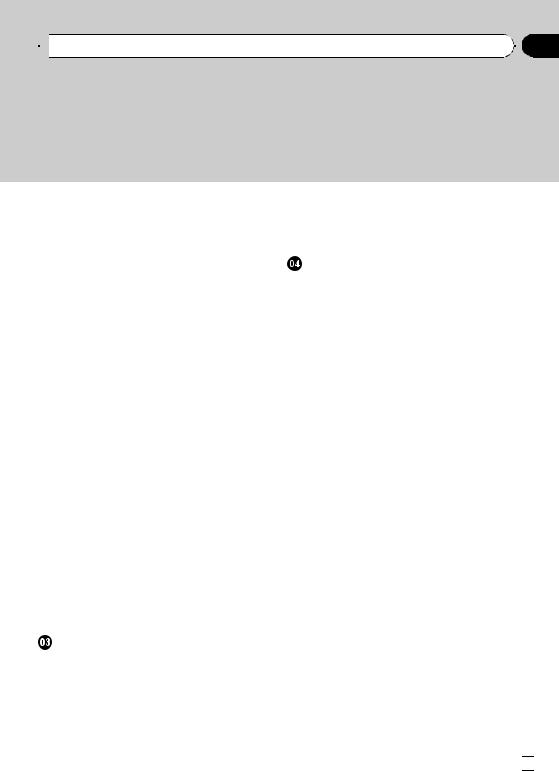
 Contents
Contents
– |
Stopping playback 27 |
– |
Connecting to a Bluetooth audio player |
|
automatically 27 |
–Displaying BD (Bluetooth Device) address 28
Bluetooth Telephone |
28 |
|
|
|
||
– |
Setting up for hands-free phoning |
28 |
||||
– |
Introduction of connection and |
|
||||
|
registration |
29 |
|
|
|
|
– |
Connecting and disconnecting a |
|
||||
|
cellular phone |
29 |
|
|
|
|
– |
Making a phone call |
32 |
|
|
||
– |
Taking a phone call 33 |
|
|
|||
– |
Using the phone number list |
33 |
|
|||
– |
Using the call history |
34 |
|
|
||
– |
Using the phone book |
34 |
|
|
||
– |
Using preset numbers |
36 |
|
|
||
– |
Introduction to advanced |
|
|
|||
|
operations |
37 |
|
|
|
|
– |
Downloading phone books from your |
|||||
|
cellular phone |
38 |
|
|
|
|
– |
Transferring entries to the phone |
|
||||
|
book 39 |
|
|
|
|
|
– |
Setting the automatic connection |
39 |
||||
– |
Setting automatic answering |
39 |
|
|||
– |
Echo canceling and noise |
|
|
|||
|
reduction |
39 |
|
|
|
|
– |
Switching the ring tone 40 |
|
|
|||
–Making a call by entering phone number 40
– |
Clearing memory |
40 |
|
|
|
– |
Changing the phone book display |
||||
|
order 40 |
|
|
|
|
– |
Selecting menu language |
41 |
|
||
Audio Adjustments |
|
|
|
|
|
Introduction of audio adjustments |
42 |
||||
Using balance adjustment 42 |
|
|
|||
Using the equalizer |
42 |
|
|
|
|
– |
Recalling equalizer curves |
42 |
|||
– |
Adjusting equalizer curves |
43 |
|||
– |
Fine-adjusting equalizer curve |
43 |
|||
Adjusting loudness |
43 |
|
|
|
|
Using subwoofer output |
44 |
|
|
||
– Adjusting subwoofer settings 44 |
||
Using the high pass filter |
44 |
|
Boosting the bass |
45 |
|
Adjusting source levels |
45 |
|
Initial Settings |
|
|
Adjusting initial settings |
46 |
|
Setting the date |
46 |
|
Setting the clock |
46 |
|
Switching the warning tone 46 |
||
Switching the auxiliary setting 47 |
||
Setting the rear output and subwoofer |
||
controller 47 |
|
|
Switching the sound muting/attenuation 47 Setting the internal power amplifier 48 Switching the ever scroll 48
Activating the BT AUDIO source 48 Entering PIN code for Bluetooth wireless
connection 48 Editing device name 49
Displaying system version for repair 49 Resetting the Bluetooth wireless technology
module 49
Updating the software about Bluetooth connection 50
 Other Functions
Other Functions
Using the AUX source 51
– About AUX1 and AUX2 51
–AUX1 source: 51
–AUX2 source: 51
– |
Selecting AUX as the source 51 |
– |
Setting the AUX title 51 |
Using the external unit 51
–Selecting the external unit as the source 51
– |
Basic operation 52 |
– |
Advanced operations 52 |
Turning the clock display on or off 52 Switching the display indication and button
illumination 52
Using the PGM button 52
En  3
3


 Contents
Contents
Available accessories |
|
|
Playing songs on iPod |
54 |
|
– |
Basic operation |
54 |
– |
Displaying text information on |
|
|
iPod 54 |
|
– |
Browsing for a song 54 |
|
– |
Introduction to advanced |
|
|
operations 54 |
|
–Playing songs in a random order (shuffle) 55
XM tuner 55 |
|
|
– |
Listening to XM Satellite Radio |
55 |
– |
Selecting an XM channel directly |
55 |
– |
Switching the XM display 55 |
|
– |
Storing and recalling broadcast |
|
|
stations 55 |
|
–Switching the XM channel select mode 56
– |
Displaying the Radio ID |
56 |
|
||
SIRIUS Satellite Radio tuner |
56 |
|
|||
– |
Listening to SIRIUS Satellite Radio 56 |
||||
– |
Selecting a SIRIUS channel |
|
|||
|
directly |
57 |
|
|
|
– |
Switching the SIRIUS display |
57 |
|||
– |
Storing and recalling broadcast |
||||
|
stations |
57 |
|
|
|
– |
Introduction of advanced |
|
|||
|
operations |
57 |
|
|
|
– |
Selecting the SIRIUS channel select |
||||
|
mode |
58 |
|
|
|
– |
Using the Game Alert function |
58 |
|||
– |
Displaying the Radio ID |
59 |
|
||
– |
Using Instant Replay function |
59 |
|||
HD Radio tuner |
60 |
|
|
||
– |
Basic Operations 60 |
|
|
||
– |
Storing and recalling broadcast |
||||
|
frequencies |
60 |
|
|
|
– |
Switching the display |
60 |
|
||
– |
Introduction to advanced |
|
|||
|
operations |
61 |
|
|
|
– |
Switching the seek mode 61 |
|
|||
– |
Switching the reception mode |
61 |
|||
Multi-CD Player |
61 |
|
|
||
– |
Basic Operations 61 |
|
– |
Using CD TEXT functions |
62 |
– |
Selecting a track directly |
62 |
– |
Introduction to advanced |
|
|
operations 62 |
|
–Using compression and bass emphasis 63
– |
Using ITS playlists 63 |
|
– |
Using disc title functions 64 |
|
DVD Player 65 |
|
|
– |
Basic Operations |
65 |
– |
Selecting a disc |
65 |
– |
Selecting a folder |
65 |
–Introduction to advanced operations 65
TV tuner 67
– |
Basic Operations 67 |
– |
Storing and recalling broadcast |
|
stations 67 |
–Storing the strongest broadcast stations sequentially 68
 Additional Information
Additional Information
Troubleshooting 69 Error messages 69
Handling guideline of discs and player 71 Dual Discs 71
Compressed audio compatibility 71 Compressed audio files on the disc 72
– Example of a hierarchy 72 USB audio player/USB memory 72
– USB audio player/USB memory compatibility 72
–Handling guideline and supplemental information 73
iPod |
74 |
– |
About handling the iPod 74 |
– |
About iPod settings 74 |
Bluetooth profiles 74
Specifications 75
 4
4 En
En
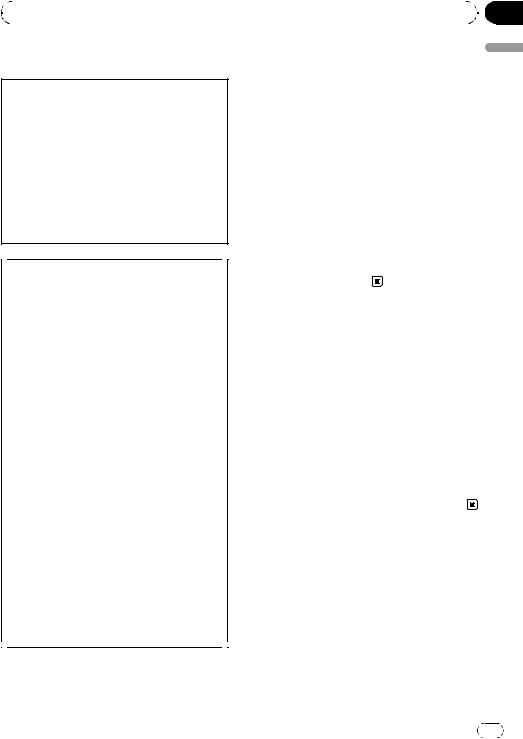
|
Section |
Before You Start |
01 |
|
|
Information to User
FCC ID: AJDK016
MODEL NO.: DEH-P7000BT IC: 775E-K016
This device complies with Part 15 of FCC Rules and RSS-Gen of IC Rules. Operation is subject to the following two conditions: (1) this device may not cause interference, and (2) this device must accept any interference, including interference that may cause undesired operation of this device.
MADE IN THAILAND
This equipment has been tested and found to comply with the limits for a class B digital device, pursuant to Part 15 of the FCC Rules.
These limits are designed to provide reasonable protection against harmful interference in a residential installation.
This equipment generates, uses and can radiate radio frequency energy and, if not installed and used in accordance with the instructions, may cause harmful interference to radio communications. However, there is no guarantee that interference will not occur in a particular installation.
If this equipment dose cause harmful interference to radio or television reception, which can be determined by turning the equipment off and on, the user is encouraged to try to correct the interference by one or more of the following measures:
!Reorient or relocate the receiving antenna.
!Increase the separation between the equipment and receiver.
!Connect the equipment into an outlet on a circuit different from that to which the receiver is connected.
!Consult the dealer or an experienced radio/ TV technician for help.
! This transmitter must not be co-located or op- |
YouBefore |
|
Alteration or modifications carried out without |
|
|
appropriate authorization may invalidate the |
|
|
user’s right to operate the equipment. |
|
|
|
Start |
|
erated in conjunction with any other antenna |
||
|
||
or transmitter. |
|
|
! This equipment complies with FCC/IC radia- |
|
|
tion exposure limits set forth for uncontrolled |
|
|
equipment and meets the FCC/IC radio fre- |
|
|
quency (RF) Exposure Guidelines in Supple- |
|
|
ment C to OET65 and RSS-102 of the IC radio |
|
|
frequency (RF) exposure rules. This equipment |
|
|
has very low levels of RF energy that it is |
|
|
deemed to comply without testing of specific |
|
|
absorption ratio (SAR). |
|
|
For Canadian model |
|
|
|
|
|
Operation is subject to the following two condi- |
|
|
tions: |
|
|
(1) This device may not cause harmful interfer- |
|
|
ence, and (2) this device must accept any inter- |
|
|
ference received, including interference that |
|
|
may cause undesired operation. |
|
|
|
|
|
|
|
|
This Class B digital apparatus complies with |
|
|
Canadian ICES-003. |
|
|
|
|
|
About this unit |
|
|
The tuner frequencies on this unit are allo- |
|
|
cated for use in North America. Use in other |
|
|
areas may result in poor reception. |
|
En |
5 |
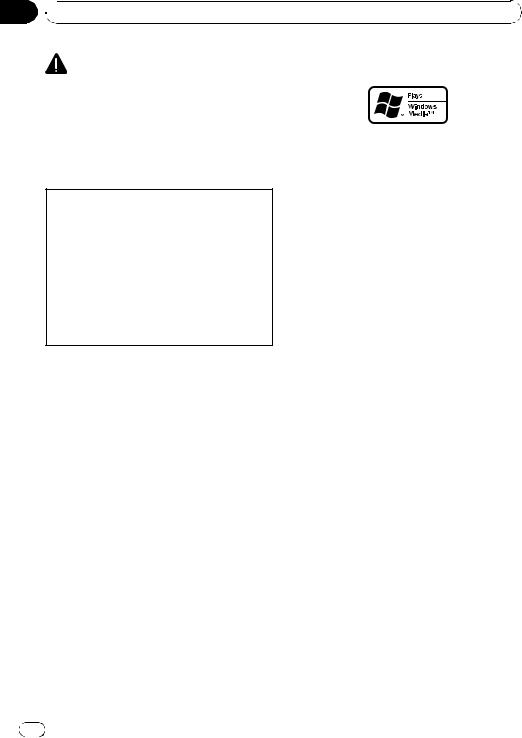
Section
01  Before You Start
Before You Start
About WMA
WARNING
Handling the cord on this product or cords associated with accessories sold with the product may expose you to chemicals listed on proposition 65 known to the State of California and other governmental entities to cause cancer and birth defects or other reproductive harm. Wash hands after handling.
CAUTION:
USE OF CONTROL OR ADJUSTMENT OR PERFORMANCE OF PROCEDURES OTHER THAN THOSE SPECIFIED HEREIN MAY RESULT IN HAZARDOUS RADIATION EXPOSURE.
CAUTION:
THE USE OF OPTICAL INSTRUMENTS WITH THIS PRODUCT WILL INCREASE EYE HAZARD.
 CAUTION
CAUTION
!Do not allow this unit to come into contact with liquids. Electrical shock could result. Also, damage to this unit, smoke, and overheating could result from contact with liquids.
!Keep this manual handy as a reference for operating procedures and precautions.
!Always keep the volume low enough so that you can hear sounds from outside the vehicle.
!Protect this unit from moisture.
!If the battery is disconnected or discharged, the preset memory will be erased and must be reprogrammed.
 Important (Serial number)
Important (Serial number)
The Windows Media™ logo printed on the box indicates that this unit can play back WMA data.
Windows Media and the Windows logo are trademarks or registered trademarks of Microsoft Corporation in the United States and/or other countries.
!This unit may not operate correctly depending on the application used to encode WMA files.
About MP3
Supply of this product only conveys a license for private, non-commercial use and does not convey a license nor imply any right to use this product in any commercial (i.e. revenuegenerating) real time broadcasting (terrestrial, satellite, cable and/or any other media), broadcasting/streaming via internet, intranets and/ or other networks or in other electronic content distribution systems, such as pay-audio or audio-on-demand applications. An independent license for such use is required. For details, please visit http://www.mp3licensing.com.
About AAC
This unit plays back AAC files encoded by iTunes®.
iTunes is a trademark of Apple Inc., registered in the U.S. and other countries.
The serial number is located on the bottom of this unit. For your own security and convenience, be sure to record this number on the enclosed warranty card.
Portable audio player compatibility
! Inquire at the manufacturer about your USB portable audio player/USB memory.
This unit corresponds to the following.
—USB MSC (Mass Storage Class) compliant portable audio player and memory
—WMA, MP3, AAC and WAV file playback
6 |
En |
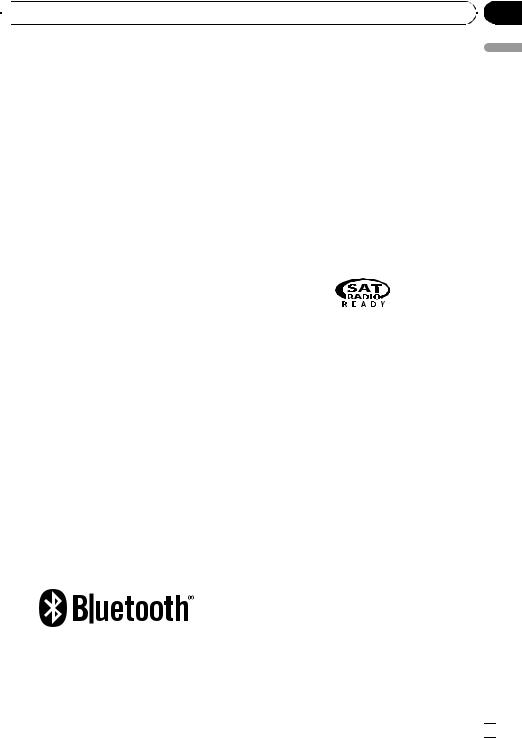
 Before You Start
Before You Start
For details about the compatibility, refer to
USB audio player/USB memory compatibility on page 72.
iPod® compatibility
This unit can control and listen to songs on an iPod.
!This unit supports only the following iPods. Supported iPod software versions are shown below. Older versions of iPod software may not be supported.
—iPod nano first generation (software version 1.3.1)
—iPod nano second generation (software version 1.2.1)
—iPod nano third generation (software version 1.0.2)
—iPod fifth generation (software version 1.2.1)
—iPod classic (software version 1.0.2)
—iPod touch (software version 1.1.1)
!Operations may vary depending on the software version of iPod.
!When using an iPod, iPod Dock Connector to USB Cable is required.
!Pioneer CD-IU50 interface cable is also available. For details, consult your dealer.
!This unit can control previous generations
iPod models with a Pioneer iPod adapter (e.g. CD-IB100N).
For details concerning operation with the iPod adapter, refer to Playing songs on iPod on page 54.
!iPod is a trademark of Apple Inc., registered in the U.S. and other countries.
About Bluetooth
Bluetooth is a short-range wireless radio connectivity technology that is developed as a cable replacement for mobile phones, hand-
held PCs and other devices. Bluetooth operates in 2.4 GHz frequency range and transmits voice and data at speeds up to 1 megabit per second. Bluetooth was launched by a special interest group (SIG) that comprises of Ericsson Inc., Intel Corp., Nokia Corp., Toshiba and IBM in 1998, and it is currently developed by nearly 2 000 companies worldwide.
!The Bluetooth word mark and logos are owned by the Bluetooth SIG, Inc. and any use of such marks by Pioneer Corporation is under license. Other trademarks and trade names are those of their respective owners.
About the SAT RADIO READY mark
The SAT RADIO READY mark indicates that the Satellite Radio Tuner for Pioneer (i.e., XM tuner and Sirius satellite tuner which are sold separately) can be controlled by this unit. Please inquire to your dealer or nearest authorized Pioneer service station regarding the satellite radio tuner that can be connected to this unit. For satellite radio tuner operation, please refer to the satellite radio tuner owner’s manual.
!The system will use direct satellite-to-recei- ver broadcasting technology to provide listeners in their cars and at home with crystal-clear sound seamlessly from coast to coast. Satellite radio will create and package over 100 channels of digital-quality music, news, sports, talk and children’s programming.
!“SAT Radio”, the SAT Radio logo and all related marks are trademarks of Sirius Satellite Radio inc., and XM Satellite Radio Inc.
About HD Radio
!The HD Radio Ready logo is a proprietary trademark of iBiquity Digital Corp.
Section
01
Start You Before
En  7
7

Section
01  Before You Start
Before You Start
 CAUTION
CAUTION
!Pioneer accepts no responsibility for data lost on the USB portable audio player/USB memory even if that data is lost while using this unit.
!Pioneer accepts no responsibility for data lost
on the iPod even if that data is lost while using this unit.
http://www.pioneerelectronics.com
1Register your product. We will keep the details of your purchase on file to help you refer to this information in the event of an insurance claim such as loss or theft.
2Receive updates on the latest products and technologies.
3Download owner’s manuals, order product
catalogues, research new products, and much more.
After-sales service for Pioneer products
Please contact the dealer or distributor from where you purchased this unit for after-sales service (including warranty conditions) or any other information. In case the necessary information is not available, please contact the companies listed below:
Please do not ship your unit to the companies at the addresses listed below for repair without advance contact.
U.S.A.
Pioneer Electronics (USA) Inc. CUSTOMER SUPPORT DIVISION P.O. Box 1760
Long Beach, CA 90801-1760 800-421-1404
CANADA
Pioneer Electronics of Canada, Inc. CUSTOMER SATISFACTION DEPARTMENT 300 Allstate Parkway
Markham, Ontario L3R 0P2 1-877-283-5901 905-479-4411
For warranty information please see the Limited Warranty sheet included with this unit.
Visit our website
Visit us at the following site:
In case of trouble
Should this product fail to operate properly, contact your dealer or nearest authorized Pioneer Service Station.
Protecting your unit from theft
The front panel can be detached to deter theft.
!If the front panel is not detached from the head unit within five seconds of turning off the ignition, a warning tone sounds.
!You can turn off the warning tone. See
Switching the warning tone on page 46.
 Important
Important
!Handle gently when removing or attaching the front panel.
!Avoid subjecting the front panel to excessive shock.
!Keep the front panel out of direct sunlight and high temperatures.
Removing the front panel
1Press OPEN to open the front panel.
2Grip the left side of the front panel and pull it gently outward.
Take care not to grip it too tightly or to drop the front panel and protect it from contact with water or other fluids to prevent permanent damage.
8 |
En |
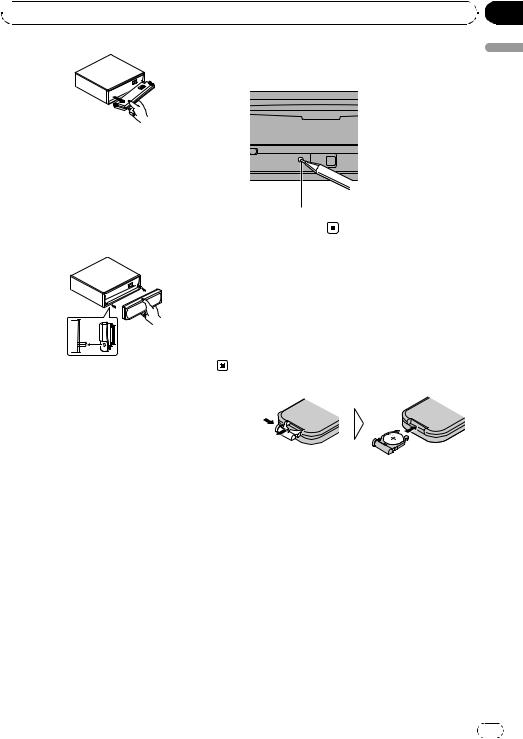
 Before You Start
Before You Start
3 Put the front panel into the provided protective case for safe keeping.
Attaching the front panel
% Reattach the front panel by holding it upright to the unit and clipping it securely into the mounting hooks.
% Press RESET with a pen tip or other pointed instrument.
RESET button
Section
01
Start You Before
Resetting the microprocessor
The microprocessor must be reset under the following conditions:
!Prior to using this unit for the first time after installation
!If the unit fails to operate properly
!When strange or incorrect messages appear on the display
Use and care of the remote control
Installing the battery
Slide the tray on the back of the remote control out and insert the battery with the plus (+) and minus (–) poles aligned properly.
!When using for the first time, pull out the film protruding from the tray.
 WARNING
WARNING
Keep the battery out of the reach of children. Should the battery be swallowed, consult a doctor immediately.
 CAUTION
CAUTION
!Use one CR2025 (3 V) lithium battery.
!Remove the battery if the remote control is not used for a month or longer.
!There is a danger of explosion if the battery is incorrectly replaced. Replace only with the same or equivalent type.
!Do not handle the battery with metallic tools.
!Do not store the battery with metallic objects.
En |
9 |

Section
01 Before You Start
Before You Start
!If the battery leaks, wipe the remote control completely clean and install a new battery.
!When disposing of used batteries, comply with governmental regulations or environmental public institutions’ rules that apply in your country/area.
!“Perchlorate Material – special handling may apply.
See www.dtsc.ca.gov/hazardouswaste/ perchlorate. (Applicable to California, U.S.A.)”
Using the remote control
Point the remote control in the direction of the front panel to operate.
!The remote control may not function properly in direct sunlight.
 Important
Important
!Do not store the remote control in high temperatures or direct sunlight.
!Do not let the remote control fall onto the
floor, where it may become jammed under the brake or accelerator pedal.
 10
10 En
En
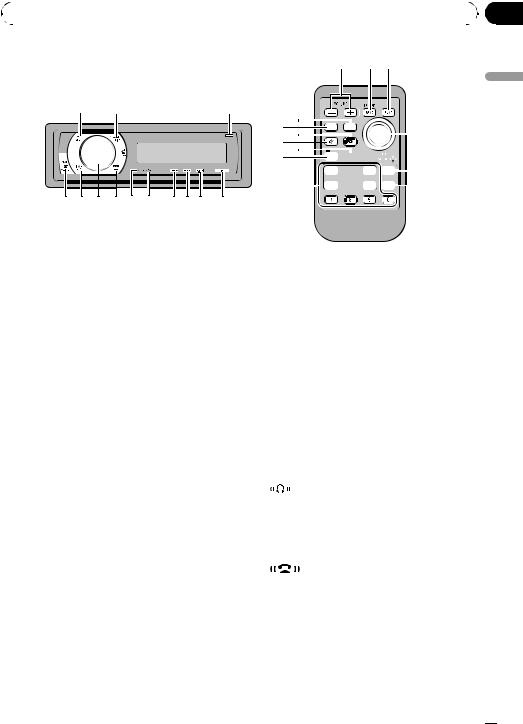
|
|
Section |
Operating this unit |
02 |
|
|
|
|
e |
c f |
|
1 |
2 |
3 |
d c b a 9 8 765 4
What’s What
Head unit
1 SRC/OFF button
This unit is turned on by selecting a source. Press to cycle through all the available sources.
2 DISP/SCROLL button
Press to select different displays.
3 OPEN button
Press to open the front panel.
4 LIST button
Press to display the disc title list, track title list, folder list, file list, preset channel list or phone number list depending on the source.
5 S.Rtrv/SAT MODE button
Press to switch Sound Retriever settings. When XM tuner or SIRIUS tuner is selected as the source, press to change the channel select mode.
When SIRIUS tuner is selected as the source, press and hold to perform the Instant Replay mode.
o
1m n

 g k l
g k l









 h j
h j



 i
i
6 RDM/ /iPod button
/iPod button
Press to turn random function on or off while using CD or USB.
While using an iPod, press to shuffle all tracks.
Press and hold to switch the control mode while using an iPod.
If using the iPod with an interface adapter (CD-IB100N), press to switch the shuffle function.
7 CLOCK/DISP OFF button
Press to change to the clock display.
Press and hold to turn the display indication and button illumination off or on.
8 |
indicator |
|
Lights up when your Bluetooth audio player |
|
is connected via Bluetooth wireless technol- |
|
ogy. |
|
! While connecting, this indicator flashes. |
9 |
indicator |
|
Lights up when your cellular phone is con- |
|
nected via Bluetooth wireless technology. |
!While connecting, this indicator flashes.
!While phone connection is not completed, this indicator flashes.
unit this Operating
En  11
11
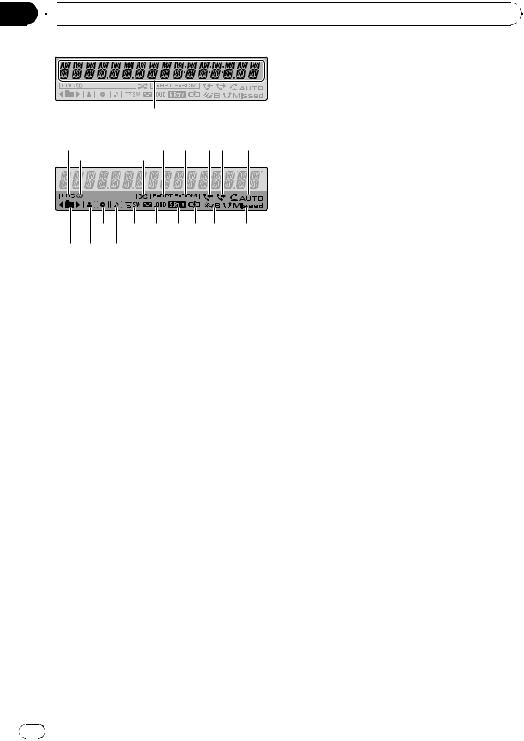
Section
02  Operating this unit
Operating this unit
|
1 |
|
23 |
4 5 6 78 |
9 |
c e f g h i j a b d
a MUTE/HOLD button
Press to turn off the sound. To turn on the sound, press again.
While talking on the phone, press to put the call on hold.
b MULTI-CONTROL
Move to perform manual seek tuning, fast forward, reverse and track search controls. Also used for controlling functions.
Turn to increase or decrease the volume.
c BAND/ESC button
Press to select among three FM bands and one AM band.
Press to return to the ordinary display when operating the menu.
d PHONE/ /CONNECT button
/CONNECT button
Press to select the phone as the source. While operating a phone source, press to end a call, reject an incoming call or cancel making a call.
Press and hold to perform Bluetooth connection.
Remote control
Operation is the same as when using the buttons on the head unit.
e VOLUME buttons
Press to increase or decrease the volume.
fFUNCTION button
Press to select functions.
gThumb pad
Move to perform manual seek tuning, fast forward, reverse and track search controls. Also used for controlling functions.
Functions are the same as MULTI-CONTROL except for volume control.
h DIRECT button
Press to directly select the desired track.
i CLEAR button
Press to cancel the input number when 0 to 9 are used.
j 0 to 9 buttons
Press to directly select the desired track, preset tuning or disc. Buttons 1 to 6 can operate the preset tuning for the tuner or disc number search for the multi-CD player.
k  (off hook) button
(off hook) button
Press to start talking on the phone while operating a phone source.
l  (on hook) button
(on hook) button
While operating the phone source, press to end a call or reject an incoming call.
m 
 (mute) button
(mute) button
Press to turn off the sound. To turn on the sound, press again.
n PGM button
Press to operate the preprogrammed functions for each source. (Refer to Using the PGM button on page 52.)
o AUDIO button
Press to select an audio function.
12 En

|
Section |
Operating this unit |
02 |
|
|
Display indication
1 Main display section
Displays band, frequency, elapsed playback time and other settings.
!Tuner
Band and frequency are displayed.
!Bulit-in CD player, USB, iPod
Elapsed playback time and literal information are displayed.
2 LOC indicator
Appears when local seek tuning is on.
3 5 (stereo) indicator
Appears when the selected frequency is being broadcast in stereo.
4  (shuffle) indicator
(shuffle) indicator
Appears when shuffle function is on while iPod source is being selected.
5 F-RPT indicator
Appears when folder repeat is on.
When repeat function is on, only RPT is displayed.
6 F-RDM indicator
Appears when folder random is on. When random function is on, only RDM is displayed.
7 |
(received call) indicator |
|
Appears when received call list is displayed |
|
while telephone source is being selected. |
8 |
(dialled call) indicator |
|
Appears when dialled call list is displayed |
|
while telephone source is being selected. |
9 |
(auto answer) indicator |
|
Shows when the automatic answering func- |
|
tion is on (for more details, refer to Setting |
|
automatic answering on page 39). |
a |
(folder) indicator |
|
Appears when operating list function. |
|
When an upper tier folder or menu exists, c |
|
appears. |
When a lower tier folder or menu exists, d appears.
b  (artist) indicator
(artist) indicator
Appears when the disc (track) artist name is displayed on the main display section. Appears when artist search refinement on the iPod browsing function is in use.
c  (disc) indicator
(disc) indicator
Appears when the disc (album) name is displayed on the main display section. Appears when album search refinement on the iPod browsing function is in use.
d  (song) indicator
(song) indicator
Appears when the track (song) name is displayed on the main display section. Appears when song search refinement on the iPod browsing function is in use.
e
 (subwoofer) indicator
(subwoofer) indicator
Appears when subwoofer is on.
f (loudness) indicator
(loudness) indicator
Appears when loudness is on.
g (Sound Retriever) indicator
(Sound Retriever) indicator
Appears when Sound Retriever function is on.
h (iPod connection) indicator
(iPod connection) indicator
Appears when the iPod connection is recognized while USB source is being selected.
i  (phone book) indicator
(phone book) indicator
Appears when phone book list is displayed while telephone source is being selected.
j 


 (missed call) indicator
(missed call) indicator
Appears when there are missed call log. Appears when missed call list is displayed while telephone source is being selected.
unit this Operating
En  13
13

Section |
|
|
|
|
02 |
|
Operating this unit |
|
|
|
|
|
|
|
|
Basic Operations |
! Charging the portable audio player using |
||
|
Power ON/OFF |
car’s DC power source while connecting it to |
||
|
AUX input may generate noise. In this case, |
|||
|
Turning the unit on |
stop charging. |
||
|
! External unit refers to a Pioneer product (such |
|||
|
% Press SRC to turn the unit on. |
|||
|
as ones available in the future) that, although |
|||
|
|
|
incompatible as a source, enables control of |
|
|
Turning the unit off |
basic functions with this unit. Two external |
||
|
% Press OFF and hold until the unit turns |
units can be controlled with this unit. When |
||
|
two external units are connected, the external |
|||
|
off. |
|||
|
unit is automatically allocated to external unit |
|||
|
|
|
||
|
|
|
1 or external unit 2 by this unit. |
|
|
Selecting a source |
! When this unit’s blue/white lead is connected |
||
|
You can select a source you want to listen to. |
to the vehicle’s auto-antenna relay control |
||
|
terminal, the vehicle’s antenna extends when |
|||
|
To switch to the built-in CD player, load a disc |
|||
|
this unit’s source is turned on. To retract the |
|||
|
in the unit (refer to page 16). |
|||
|
antenna, turn the source off. |
|||
|
|
|
||
|
% Press SRC repeatedly to switch be- |
|
|
|
|
tween the following sources. |
Adjusting the volume |
||
|
XM tuner—Sirius tuner—HD Radio— |
|||
|
|
|
||
|
Tuner—Television—DVD player/Multi- |
% Use MULTI-CONTROL to adjust the |
||
|
DVD player—Built-in CD player—Multi- |
sound level. |
||
|
CD player—iPod—USB—External unit 1— |
|
|
|
|
External unit 2—AUX1—AUX2—BT Audio |
|
|
|
|
—BT Telephone |
|
|
|
 Notes
Notes
!In the following cases, the sound source will not change.
—When no unit corresponding to the selected source is connected.
—When there is no disc or magazine in the player.
—When the iPod is not connected to this unit.
—When AUX (auxiliary input) is set to off (refer to page 47).
—When the BT audio source is set to off (refer to Activating the BT AUDIO source on page 48).
!If the HD Radio tuner is connected to this unit, tuner source is skipped.
!AUX1 is set to on by default. Turn off the AUX1 when not in use (refer to Switching the auxiliary setting on page 47).
 14
14 En
En

 Operating this unit
Operating this unit
Tuner |
Using the remote control |
||
Basic Operations |
% When you find a frequency that you |
||
want to store in memory, press one of pre- |
|||
% |
Select a band |
||
set tuning buttons 1 to 6 and hold until the |
|||
Press BAND/ESC. |
preset number stops flashing. |
||
# Band can be selected from among FM1, FM2, |
The number you have pressed will flash in the |
||
FM3 or AM. |
preset number indicator and then remain lit. |
||
% Manual tuning (step by step) |
The selected radio station frequency has been |
||
stored in memory. |
|||
Push MULTI-CONTROL left or right. |
|||
The next time you press the same preset tun- |
|||
|
|
||
% |
Seek tuning |
ing button the radio station frequency is re- |
|
called from memory. |
|||
Push and hold MULTI-CONTROL left or right, |
|||
# You can also recall radio station frequencies |
|||
and then release. |
|||
assigned to preset tuning numbers by pushing |
|||
# You can cancel seek tuning by pushing |
|||
MULTI-CONTROL up or down during the fre- |
|||
MULTI-CONTROL left or right. |
|||
quency display. |
|||
# While pushing and holding MULTI-CONTROL |
|||
|
|||
left or right, you can skip stations. Seek tuning |
|
||
starts as soon as you release MULTI-CONTROL. |
Introduction to advanced |
||
Storing and recalling broadcast |
operations |
||
1 Press MULTI-CONTROL to display the |
|||
frequencies |
|||
main menu. |
|||
You can easily store up to six broadcast fre- |
2 Use MULTI-CONTROL to select |
||
quencies for later recall. |
|||
FUNCTION. |
|||
! Six stations for each band can be stored in |
|||
Turn to change the menu option. Press to se- |
|||
|
memory. |
||
|
lect. |
||
|
|
||
1 |
Press LIST. |
The function menu is displayed. |
|
Preset screen is displayed. |
3 Turn MULTI-CONTROL to select the |
||
|
|
||
2 Use MULTI-CONTROL to store the se- |
function. |
||
lected frequency in memory. |
BSM (best stations memory)—LOCAL (local |
||
Turn to change the preset number. Press and |
seek tuning) |
||
hold to store. |
|
||
3 Use MULTI-CONTROL to select the de- |
Notes |
||
! You can also select the function by pressing |
|||
sired station. |
|||
FUNCTION on the remote control. |
|||
Turn to change the station. Press to select. |
|||
! To return to the ordinary display, press |
|||
# You can also change the station by pushing |
|||
BAND/ESC. |
|||
MULTI-CONTROL up or down. |
|||
|
|||
# To return to the ordinary display, press |
|
||
BAND/ESC or LIST. |
Storing the strongest broadcast |
||
# If you do not operate the list within about 30 |
frequencies |
||
seconds, the display automatically returns to the |
|||
|
|||
ordinary display. |
BSM (best stations memory) lets you automa- |
|
tically store the six strongest broadcast fre- |
||
|
||
|
quencies. |
Section
02
unit this Operating
En  15
15
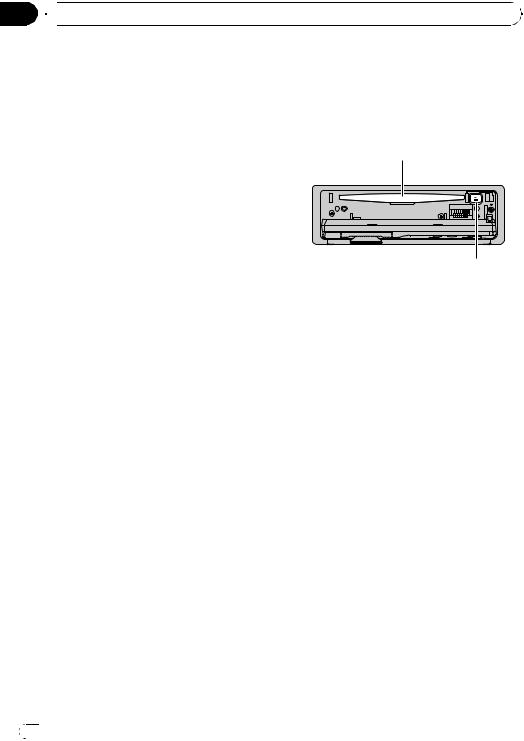
Section
02  Operating this unit
Operating this unit
1 |
Display the function menu. |
Built-in CD Player |
|
Refer to Introduction to advanced operations |
Basic Operations |
||
on the previous page. |
|||
2 |
Use MULTI-CONTROL to select BSM in |
% Open the front panel |
|
Press OPEN . |
|||
the function menu. |
|||
Disc loading slot appears. |
|||
|
|
||
3 Press MULTI-CONTROL to turn BSM on.
The six strongest broadcast frequencies are stored in the order of their signal strength.
# To cancel, press MULTI-CONTROL again.
Tuning in strong signals
Local seek tuning lets you tune in only those radio stations with sufficiently strong signals for good reception.
1 Display the function menu.
Refer to Introduction to advanced operations on the previous page.
2Use MULTI-CONTROL to select LOCAL in the function menu.
3Press MULTI-CONTROL to turn local seek tuning on.
# To turn local seek tuning off, press
MULTI-CONTROL again.
4 Push MULTI-CONTROL left or right to set the sensitivity.
FM: LEVEL 1—LEVEL 2—LEVEL 3—LEVEL 4 AM: LEVEL 1—LEVEL 2
The LEVEL 4 setting allows reception of only the strongest stations, while lower settings let you receive progressively weaker stations.
Disc loading slot
h (eject) button
#When loading a disc, face the label side of a disc up.
#To avoid a malfunction, make sure that no metal objects come into contact with the terminals when the front panel is open.
%Eject a disc
Press h (eject).
%Select a folder
Push MULTI-CONTROL up or down.
# You cannot select a folder that does not have a compressed audio file recorded in it.
% Select a track
Push MULTI-CONTROL left or right.
% Fast forward or reverse
Push and hold MULTI-CONTROL left or right.
# When playing compressed audio, there is no sound on fast forward or reverse.
% Return to root folder
Press and hold BAND/ESC.
# If folder 01 (ROOT) contains no files, playback commences with folder 02.
% Switch between compressed audio and CD-DA
Press BAND/ESC.
# This operation is available only when playing CD-EXTRA or MIXED-MODE CDs.
16 En
En

|
Section |
Operating this unit |
02 |
|
|
# If you have switched between compressed audio and CD-DA, playback starts at the first track on the disc.
 Notes
Notes
!The built-in CD player can play back audio CD and compressed audio recorded on a CDROM. (Refer to page 72 for files that can be played back.)
!Read the precautions for discs and player on page 71.
!A disc has already been inserted, press SRC to select the built-in CD player.
!There is sometimes a delay between starting up disc playback and the sound being issued. When being read, FORMAT READ is displayed.
!If an error message is displayed, refer to Error messages on page 69.
!Playback is carried out in order of file number. Folders are skipped if they contain no files. (If folder 01 (ROOT) contains no files, playback commences with folder 02.)
Selecting a track directly
When using the remote control, you can select a track directly by entering the desired track number.
!When audio files are being played back, you can select track in the current folder.
1 Press DIRECT.
Track number input display appears.
2 Press 0 to 9 to enter the desired track number.
# You can cancel the input number by pressing
CLEAR.
3 Press DIRECT.
The track for the entered number will play.
# After entering the number input mode, if you do not perform an operation within about eight seconds, the mode is automatically canceled.
Displaying text information on disc
% Press DISP to select the desired text information.
For title entered CD
Play time—disc title
For CD TEXT discs
Play time—disc title—disc artist name—track title—track artist name
For WMA/MP3/AAC
Play time—folder name—file name—track title—artist name—album title—comment— bit rate
For WAV
Play time—folder name—file name—sam- pling frequency
 Notes
Notes
!You can scroll to the left of the title by pressing and holding DISP.
!Audio CD that contains certain information such as text and/or number is CD TEXT.
!If specific information is not recorded on a disc, title or name is not displayed.
!Depending on the version of iTunes® used to write MP3 files onto a disc, comment information may not be correctly displayed.
!Depending on the version of Windows Media Player used to encode WMA files, album names and other text information may not be correctly displayed.
!When playing back VBR (variable bit rate)-re- corded WMA files, the average bit rate value is displayed.
!When playing back VBR (variable bit rate)-re- corded MP3 files, VBR is displayed instead of bit rate value.
!The sampling frequency shown in the display may be abbreviated.
!When Ever Scroll is set to ON at the initial setting, text information scrolls continuously in the display. Refer to Switching the ever scroll on page 48.
unit this Operating
En  17
17

Section
02  Operating this unit
Operating this unit
Selecting tracks from the track title list
Track title list lets you see the list of track titles on a CD TEXT disc and select one of them to play back.
1 Press LIST to switch to the track title list mode.
#To return to the previous list (the folder one level higher), push MULTI-CONTROL left.
#To return to the ordinary display, press
BAND/ESC or LIST.
#If you do not operate the list within about 30 seconds, the display automatically returns to the ordinary display.
2 Use MULTI-CONTROL to select the desired track title.
Turn to change the track title. Press to play.
#You can also change the track title by pushing
MULTI-CONTROL up or down.
#You can also play the track by pushing
MULTI-CONTROL right.
#To return to the ordinary display, press
BAND/ESC or LIST.
#If you do not operate the list within about 30 seconds, the display automatically returns to the ordinary display.
Selecting files from the file name list
File name list lets you see the list of file names (or folder names) and select one of them to playback.
1Press LIST to switch to the file name list mode.
Names of files and folders appear in the display.
2Use MULTI-CONTROL to select the desired file name (or folder name).
Turn to change the name of file or folder.
—when a file is selected, press to play.
—when a folder is selected, press to see a list of files (or folders) in the seleted folder.
—when a folder is selected, press and hold to play a song in the selected folder.
#You can also play the file by pushing
MULTI-CONTROL right.
#You can also play a song in the selected folder by pushing and holding MULTI-CONTROL right.
Introduction to advanced operations
1Press MULTI-CONTROL to display the main menu.
2Use MULTI-CONTROL to select FUNCTION.
Turn to change the menu option. Press to select.
The function menu is displayed.
3Turn MULTI-CONTROL to select the function.
REPEAT (repeat play)—RANDOM (random play)—SCAN (scan play)—PAUSE (pause)— S. RTRV (sound retriever)—TITLE INPUT (disc title input)
 Notes
Notes
!You can also select the function by pressing FUNCTION on the remote control.
!To return to the ordinary display, press
BAND/ESC.
!If you do not operate functions except for TITLE INPUT within about 30 seconds, the display automatically returns to the ordinary display.
!When playing a compressed audio disc or CD TEXT disc, you cannot switch to disc title input display.
Selecting a repeat play range
1 Display the function menu.
Refer to Introduction to advanced operations on this page.
 18
18 En
En

 Operating this unit
Operating this unit
2Use MULTI-CONTROL to select REPEAT in the function menu.
3Press MULTI-CONTROL to select the desired setting.
!DISC – Repeat all tracks
!TRACK – Repeat the current track
!FOLDER – Repeat the current folder
#If you select another folder during repeat play, the repeat play range changes to disc repeat.
#Performing track search or fast forward/reverse during TRACK (track repeat) changes the repeat play range to disc/folder.
#When FOLDER (folder repeat) is selected, it is not possible to play back a subfolder of that folder.
Playing tracks in random order
Tracks in a selected repeat range are played in random order.
% Press RDM to turn random play on.
Tracks play in a random order.
# To turn random play off, press RDM again.
 Note
Note
You can also turn this function on or off in the menu that appears by using MULTI-CONTROL.
Scanning folders and tracks
Scan play searches the song within the selected repeat range.
1 Display the function menu.
Refer to Introduction to advanced operations on the previous page.
2Use MULTI-CONTROL to select SCAN in the function menu.
3Press MULTI-CONTROL to turn scan play
on.
The first 10 seconds of each track is played.
4 When you find the desired track press MULTI-CONTROL to turn scan play off.
#If the display has automatically returned to the playback display, select SCAN again by using
MULTI-CONTROL.
#After scanning of a disc (folder) is finished, normal playback of the tracks begins.
Pausing playback
1 Display the function menu.
Refer to Introduction to advanced operations on the previous page.
2Use MULTI-CONTROL to select PAUSE in the function menu.
3Press MULTI-CONTROL to turn pause
on.
Playback of the current track pauses.
# To turn pause off, press MULTI-CONTROL again.
Using Sound Retriever
Sound Retriever function automatically enhances compressed audio and restores rich sound.
% Press S.Rtrv repeatedly to select the desired setting.
OFF (off)—1—2
# 2 is more effective than 1.
 Note
Note
You can also perform this operation in the menu that appears by using MULTI-CONTROL.
Using disc title functions
You can input CD titles and display the title. The next time you insert a CD for which you have entered a title, the title of that CD is displayed.
Section
02
unit this Operating
En  19
19

Section
02  Operating this unit
Operating this unit
Entering disc titles
Use the disc title input feature to store up to 48 CD titles in the unit. Each title can be up to 10 characters long.
1 Display the function menu.
Refer to Introduction to advanced operations on page 18.
2Play the CD that you want to enter a title for.
3Use MULTI-CONTROL to select
TITLE INPUT in the function menu.
4Press MULTI-CONTROL to display the title input mode.
5Push MULTI-CONTROL up or down to select a letter of the alphabet.
6Press DISP to select the desired character type.
Press DISP repeatedly to switch between the following character types: Alphabet—Numbers
7Push MULTI-CONTROL left or right to move the cursor to the previous or next character position.
8Move the cursor to the last position by pushing MULTI-CONTROL right after entering the title.
When you push MULTI-CONTROL right one more time, the entered title is stored in memory.
9Press BAND/ESC to return to the playback display.
!If you connect a multi-CD player, you can input disc titles for up to 100 discs.
!When a multi-CD player that does not support
disc title functions is connected, you cannot enter disc titles in this unit.
 Notes
Notes
!Titles remain in memory, even after the disc is removed from the unit, and are recalled when the disc is reinserted.
!After data for 48 discs are stored in the memory, data for a new disc overwrites the oldest one.
 20
20 En
En

|
Section |
Operating this unit |
02 |
|
|
Playing songs on USB portable audio player/USB memory
Selecting files from the file name list
For details about the supported device, refer to Portable audio player compatibility on page 6.
Basic Operations
% Select a folder
Push MULTI-CONTROL up or down.
% Fast forward or reverse
Push and hold MULTI-CONTROL left or right.
% Select a track
Push MULTI-CONTROL left or right.
% Return to root folder
Press and hold BAND/ESC.
 Notes
Notes
!Optimum performance of this unit may not be obtained depending on the connected USB portable audio player/USB memory.
!If folder 01 (ROOT) contains no files, playback commences with folder 02.
!When the USB portable audio player having battery charging function is connected to this unit and the ignition switch is set to ACC or ON, the battery is charged.
!You can disconnect the USB portable audio player/USB memory anytime you want to finish listening to it.
!If USB portable audio player/USB memory is connected to this unit, the source is changed to USB automatically. If you do not use an USB device, disconnect it from this unit. Depending on the connected USB device, turning on the ignition switch while USB device is connected to this unit may change the source automatically.
Selecting an audio file directly in the current folder
The operation is the same as that of the builtin CD player.
Refer to Selecting a track directly on page 17.
The operation is the same as that of the builtin CD player. (Refer to Selecting files from the file name list on page 18.)
Displaying text information of an audio file
The operation is the same as that of the builtin CD player.
Refer to Displaying text information on disc on page 17.
 Notes
Notes
!If the characters recorded on the audio file are not compatible with the head unit, those characters are not displayed.
!If specific information is not recorded on an audio file, title or name is not displayed.
!The text information of some audio files may not be correctly displayed.
!You can scroll the text information to the left by pressing and holding DISP.
!When Ever Scroll is set to ON at the initial setting, text information scrolls continuously in the display. Refer to Switching the ever scroll on page 48.
Introduction to advanced operations
1Press MULTI-CONTROL to display the main menu.
2Use MULTI-CONTROL to select FUNCTION.
Turn to change the menu option. Press to select.
The function menu is displayed.
3Turn MULTI-CONTROL to select the function.
REPEAT (repeat play)—RANDOM (random play)—SCAN (scan play)—PAUSE (pause)— S. RTRV (sound retriever)
unit this Operating
En  21
21
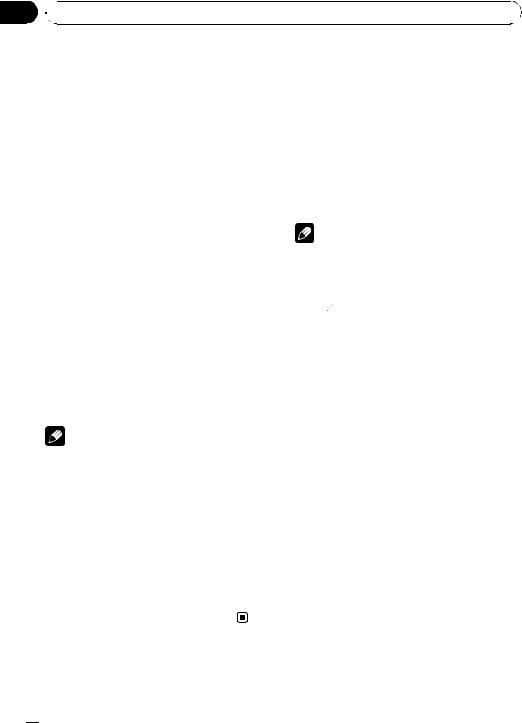
Section
02  Operating this unit
Operating this unit
Function and operation |
Playing songs on iPod |
||||
REPEAT, RANDOM, SCAN, PAUSE and |
For details about the supported iPod, refer to |
||||
S. RTRV operations are basically the same as |
|||||
iPod® compatibility on page 7. |
|||||
that of the built-in CD player. |
|
|
|||
|
|
|
|
||
Function name |
Operation |
Basic Operations |
|||
|
|
|
|||
|
Refer to Selecting a repeat play |
% Fast forward or reverse |
|||
|
range on page 18. |
||||
|
Push and hold MULTI-CONTROL left or right. |
||||
|
However, the repeat play ranges |
||||
|
you can select are different from |
% Select a track (chapter) |
|||
|
that of the built-in CD player. The |
||||
|
repeat play ranges of the USB por- |
Push MULTI-CONTROL left or right. |
|||
REPEAT |
table audio player/USB memory |
|
|
||
|
are: |
|
|
Notes |
|
|
! TRACK – Repeat just the cur- |
|
|||
|
|
|
|||
|
|
rent file |
! When using an iPod, iPod Dock Connector to |
||
|
! |
FOLDER – Repeat the current |
|||
|
|
USB Cable is required. |
|||
|
|
folder |
|
||
|
|
! Read the precautions for iPod on page 74. |
|||
|
! |
ALL – Repeat all files |
|||
|
|
|
! While iPod is connected to this unit, PIONEER |
||
|
Refer to Playing tracks in random |
||||
RANDOM |
|
(or (check mark)) is displayed on the iPod. |
|||
order on page 19. |
|
||||
|
! If an error message is displayed, refer to Error |
||||
|
|
|
|||
|
Refer to Scanning folders and |
||||
SCAN |
|
messages on page 69. |
|||
tracks on page 19. |
|
||||
|
! When the ignition switch is set to ACC or ON, |
||||
|
|
|
|||
|
Refer to Pausing playback on page |
||||
PAUSE |
|
the iPod’s battery is charged while the iPod is |
|||
19. |
|
|
|||
|
|
|
connected to this unit. |
||
|
|
|
! |
||
S. RTRV |
Refer to Using Sound Retriever on |
While the iPod is connected to this unit, the |
|||
page 19. |
|
iPod cannot be turned on or off. |
|||
|
|
||||
|
|
|
! Before connecting the dock connector of this |
||
Notes |
|
|
|
unit to the iPod, disconnect the headphones |
|
! You can also select the function by pressing |
|
from the iPod. |
|||
! The iPod is turned off about two minutes after |
|||||
FUNCTION on the remote control. |
|||||
|
the ignition switch is set to OFF. |
||||
! To return to the ordinary display, press |
|
||||
|
|
||||
BAND/ESC. |
|
|
|
|
|
! If you select another folder during repeat play, |
Browsing for a song |
||||
the repeat play range changes to ALL. |
Searching songs by category |
||||
! If you perform track search or fast forward/re- |
|||||
Operations to control an iPod with this unit is |
|||||
verse during TRACK, the repeat play range |
|||||
changes to FOLDER. |
designed to be as close to the iPod as possible |
||||
! When FOLDER is selected, it is not possible to |
to make operation and song search easy. |
||||
play back a subfolder of that folder. |
! Depending on the number of files in the |
||||
! After file or folder scanning is finished, nor- |
|
iPod, there may be a delay when displaying |
|||
mal playback of the files begins again. |
|
a list. |
|||
|
|
|
! If the characters recorded on the iPod are |
||
|
|
|
|
not compatible with this unit, those charac- |
|
|
|
|
|
ters are not displayed. |
|
|
|
|
1 |
Press LIST. |
|
 22
22 En
En

 Operating this unit
Operating this unit
2Use MULTI-CONTROL to select a category.
Turn to change the category; press to select. PLAYLISTS (playlists)—ARTISTS (artists)— ALBUMS (albums)—SONGS (songs)— PODCASTS (podcasts)—GENRES (genres)—
COMPOSERS (composers)—AUDIOBOOKS
(audiobooks)
List for the selected category is displayed.
# You can start playback throughout the selected category by pressing and holding MULTI-CONTROL. You can also perform this operation by pushing and holding
MULTI-CONTROL right.
# You can also change the category by pushing
MULTI-CONTROL up or down.
# You can also select the category by pushing
MULTI-CONTROL right.
# To return to the previous category, push
MULTI-CONTROL left.
3Repeat step 2 to find a song you want to listen to.
#To return to the top tier of categories, push and hold MULTI-CONTROL left.
#If you do not operate the list within about 30 seconds, the display automatically returns to the ordinary display.
Searching songs by alphabet
1Press LIST.
2Use MULTI-CONTROL to select a category.
Turn to change the category. Press to select.
3Press LIST to switch to alphabet search mode.
4Turn MULTI-CONTROL to select a desired alphabet.
5Press MULTI-CONTROL to display the alphabetical list.
Displaying text information on iPod
% Press DISP to select the desired text information.
Play time—song title—artist name—album title
# If the characters recorded on the iPod are not compatible with this unit, those characters are not displayed.
 Notes
Notes
!You can scroll the text information to the left by pressing and holding DISP.
!When Ever Scroll is set to ON at the initial setting, text information scrolls continuously in the display. Refer to Switching the ever scroll on page 48.
Introduction to advanced operations
1Press MULTI-CONTROL to display the main menu.
2Use MULTI-CONTROL to select FUNCTION.
Turn to change the menu option. Press to select.
The function menu is displayed.
3Turn MULTI-CONTROL to select the function.
REPEAT (repeat play)—SHUFFLE (shuffle)—
SHUFFLE ALL (shuffle all)—LINK SEARCH
(link search)—CONTROL (control mode)— PAUSE (pause)—AUDIOBOOKS (audiobook speed)—S. RTRV (sound retriever)
Function and operation
REPEAT, PAUSE and S. RTRV operations are basically the same as that of the built-in CD player.
Section
02
unit this Operating
En  23
23

Section
02  Operating this unit
Operating this unit
Function name
REPEAT
Operation
Refer to Selecting a repeat play range on page 18.
However, the repeat play ranges you can select are different from that of the built-in CD player. The repeat play ranges of the iPod are:
!ONE – Repeat the current song
!ALL – Repeat all songs in the selected list
PAUSE
Refer to Pausing playback on page 19.
S. RTRV
Refer to Using Sound Retriever on page 19.
 Notes
Notes
!You can also select the function by pressing FUNCTION on the remote control.
!To return to the ordinary display, press
BAND/ESC.
!If you do not operate functions within about 30 seconds, the display automatically returns to the ordinary display.
!When CONTROL is on, only CONTROL and S. RTRV can be operated.
Playing songs in a random order (shuffle)
1 Display the function menu.
Refer to Introduction to advanced operations on the previous page.
2Use MULTI-CONTROL to select SHUFFLE in the function menu.
3Press MULTI-CONTROL to select the desired setting.
!SONGS – Play back songs in the selected list in random order.
!ALBUMS – Play back songs from a randomly selected album in order.
!OFF – Cancel random play.
Playing all songs in a random order (shuffle all)
% Press  to turn shuffle all on.
to turn shuffle all on.
All songs on the iPod play randomly.
# To turn shuffle all off, set SHUFFLE in the FUNCTION menu to off.
 Note
Note
You can also turn this function on in the menu that appears by using MULTI-CONTROL.
Selecting songs from album list of currently playing artist
Album list of the currently selected artist is displayed. You can select an album or song from the artist name.
!Depending on the number of files in the iPod, there may be a delay when displaying a list.
1Press and hold LIST to turn link search
on.
Searches albums of the artist and displays the list.
2Use MULTI-CONTROL to select an album or song from the list.
For more details about the selecting operation, refer to step 2 of Browsing for a song on page
 Notes
Notes
!If link search is aborted, NOT FOUND is displayed.
!You can also turn this function on in the menu that appears by using MULTI-CONTROL.
Operating this unit’s iPod function from your iPod
This function cannot be operated with the following iPod models.
—iPod nano first generation (software version 1.3.1)
 24
24 En
En
